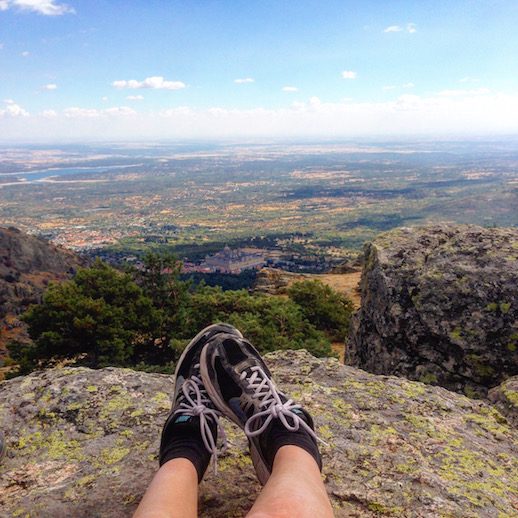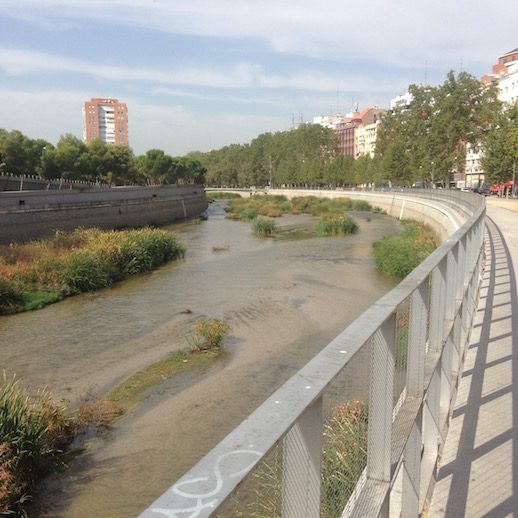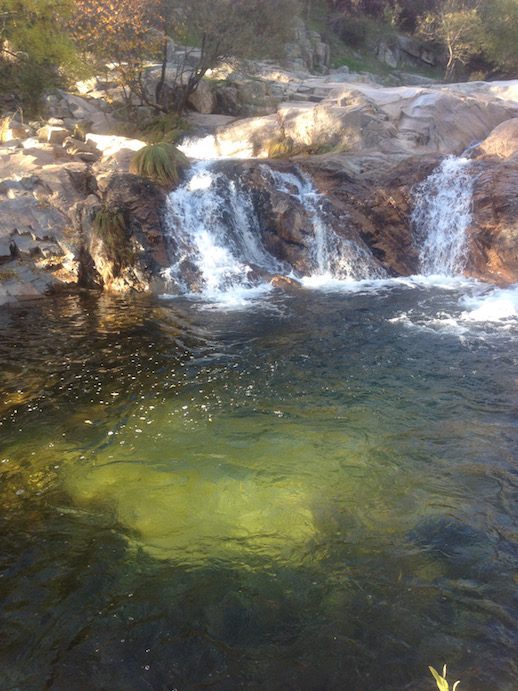
Words and pictures: Martha Sprackland
A river does flow through the centre of Madrid. It’s funny, but when I was here as a teenager I didn’t even know that. I should’ve, not only because it’s common sense that major cities almost always germinate near a waterway or a source – so necessary is it to building, to agriculture, to trade – but also because it leaves me with the feeling that I missed much of the city on my first go round. Perhaps I was a little limited in my routes, my exploring mostly nocturnal, mostly drunk. It’s probably best I didn’t find the river, those nights. This time, I’m resolved to be different. My running route from my flat in La Latina takes me across the road, past the basilica, through the dahlia garden, and down seventy wide stone steps that make me feel like Rocky Balboa. Once I’ve jogged on the spot by the side of the street, waiting for the interminable lights to change on Calle de Segovia so that I can cross the busy road, I zigzag erratically through the tidy, narrow Parque de Atenas in the shadow of the Palacio Real, ever forgetting which path is which, dodging dogwalkers, my trainers skidding slightly in the sandy gravel as I pass the viejos playing chess, until I get to the river.

The bend of the Río Manzanares cups the west perimeter of the city like a tentative hand, keeping carefully separate the streets and buildings of Madrid from the ‘lung’ of Casa de Campo, the palace hunting-grounds whose size is a thrice-over match for the city centre itself. It’s unusual for a metropolis to cohabit with a green area like this without slowly succumbing to the temptation to concrete-and-chrome it. The river doesn’t come through this dusty landscape populated by rabbits and little European deer. It’s the borderline, the frontier of urbanisation, the line drawn in the sand. Without the Manzanares, Madrid – from the Arabic al-Majrīṭ, ‘source of water’ – which was first built by the Moors in the 9th century, wouldn’t exist. That original Islamic citadel, the ancient heart of Madrid, is the old-town barrio of La Latina, where I live now, through whose narrow streets and past whose glorious domes I run each day.
One day in late October my friends and I catch the bus from Plaza Castilla – where I studied for my teaching qualification when I was eighteen – out west to Soto de Real, in the Sierra de Guadarrama. We’re on the third or fourth iteration of an Indian summer, here, and we’ve heard tell of a swimming hole called La Charca Verde, a paradisal pool of malachite-peridot-aventurine-hued water so reportedly deep and pure and clear I’ve been dreaming about it before we even get there. The Manzanares is born up in these mountains. It springs in the tiny mountain-pass pueblo of Navacerrada, from where it flows down through medieval towns and modern dams, feeding and interacting with reservoirs and tributaries before reaching Madrid. Here it is boxed and subdued, its run restricted by canalisation and municipal systems. It springs free of the slow-trap of the city at the southernmost afueras and joins forces with the Río Jarama, which in turn swells the level of the Tagus, and the coalition entire empties out, en fin, into the sea near Lisbon. Before that, though, each drop of water must first tumble through the rocky landscape of the Pedriza hiking trail, where right now Emma, Gavin, Victor and I are sprawled damp and sun-touched on the smooth flat rocks to the side of the little waterfalls, revivifying our blood again after breathless, excitable immersion in the water so tooth-achingly cold our feet burn and our hearts jitter and we get icecream headaches from ducking under the surface. The only way to do it is to throw yourself into the churn where it’s deepest, where the falls have hollowed out underwater oubliettes from years of pressure and friction. How long has it taken this water to mould the rock like this? As we lie like hauled-out seals on the warm stone, each of us connected to the others by some small contact at foot or shoulder or flank, the relentless rush and ripple of the river is all that moves in this landscape, a living, roaring presence cutting its determined channel, reshaping the world around it as it goes.

Back in the city, I run along the left bank, smelling the lavender and rosemary growing on the sand-spits down the spine of the river. The water is so shallow, here – perhaps a foot, in places – and elegant herons and cranes stand knee-deep, dipping for fish. Up ahead I’ll veer over the water, across one of the grey stone bridges, and find myself in the colder, fresher, greener air of Casa de Campo. If ever the traffic sounds too loud, if the buildings loom too large, if the rush and bustle of a capital presses against my anxiety, the wilds are just across a river, one I’ve swum in, farther back in its lifetime, one I’ve drunk from, and I can take refuge on the other side of the water until I’m steadied, until I’m ready to come home.
*
Read the previous instalments of ‘Where I’m Calling From’ here.
Martha will be reading at a few of our upcoming events: The Social Christmas Market on 17 December, our Hebden Bridge poetry & prose afternoon on 21 January, and the first of our Horse Hospital events on 27 February.
Martha Sprackland on Caught by the River/on Twitter/Martha’s website